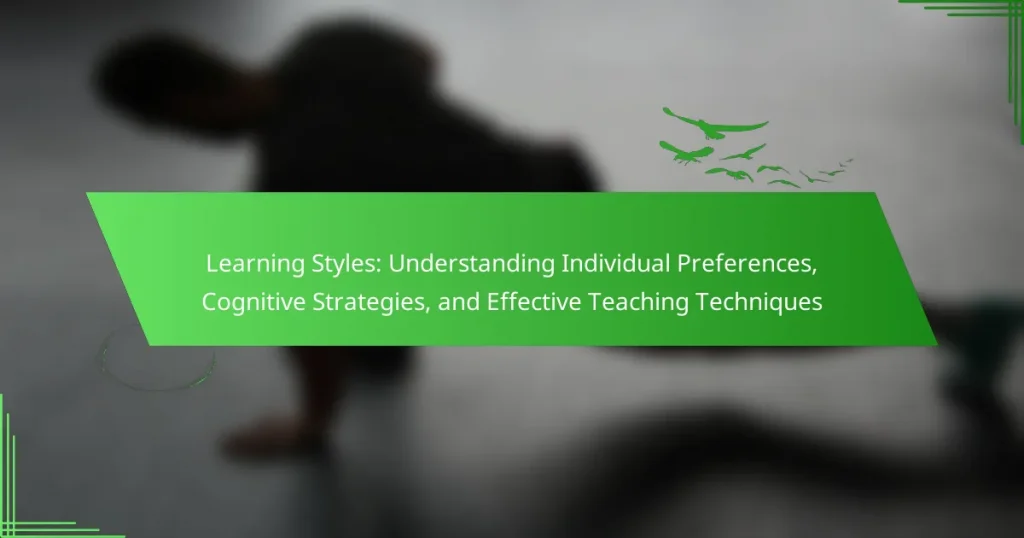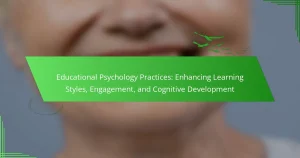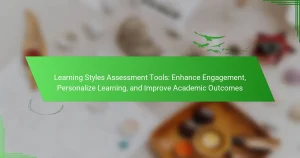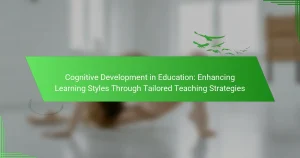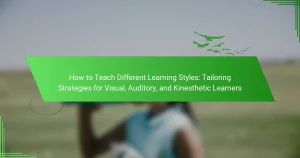Understanding learning styles can enhance student engagement and retention. This article explores individual preferences in processing information, key characteristics like sensory modalities, and effective teaching techniques. It examines how educators can tailor their approaches to accommodate diverse cognitive strategies and maximize learning outcomes. Additionally, it highlights the importance of adaptability and continuous feedback in creating an inclusive learning environment.

What are the key characteristics of learning styles?
Learning styles encompass various characteristics that reflect individual preferences in processing information. Key characteristics include auditory, visual, and kinesthetic learning preferences, which influence how students absorb and retain knowledge. Understanding these styles enables educators to tailor their teaching techniques for enhanced engagement and effectiveness. For instance, auditory learners benefit from discussions, while visual learners thrive on diagrams. Recognizing these unique attributes fosters a more inclusive learning environment.
How do individual preferences influence learning?
Individual preferences significantly influence learning by shaping how individuals absorb, process, and retain information. Understanding these preferences allows educators to tailor their approaches, enhancing engagement and effectiveness.
Learning styles, such as visual, auditory, and kinesthetic, illustrate how diverse preferences manifest in educational settings. For example, visual learners benefit from diagrams and charts, while auditory learners thrive with discussions and lectures.
Cognitive strategies also play a role in this dynamic. Students may prefer collaborative learning, which fosters social interaction, or independent study, which promotes self-paced exploration.
Effective teaching techniques, such as differentiated instruction, can address these varied preferences. By recognizing and adapting to individual learning styles, educators create a more inclusive and productive learning environment.
What cognitive strategies align with different learning styles?
Different cognitive strategies can enhance learning styles, improving retention and understanding. Visual learners benefit from diagrams and charts, while auditory learners thrive with discussions and lectures. Kinesthetic learners engage best through hands-on activities. Tailoring strategies to these styles fosters effective teaching. For example, using storytelling can help auditory learners connect with material emotionally, while visual aids can clarify complex concepts for visual learners. Adapting cognitive strategies to individual preferences maximizes learning efficiency and effectiveness.
What are the primary types of learning styles?
There are three primary types of learning styles: visual, auditory, and kinesthetic. Visual learners prefer diagrams and charts, auditory learners benefit from listening and discussions, while kinesthetic learners thrive through hands-on activities. Understanding these styles helps tailor teaching techniques to individual preferences, enhancing learning outcomes.
How do learning styles impact information retention?
Learning styles significantly influence information retention by aligning teaching methods with individual cognitive preferences. Visual learners may retain information better through diagrams, while auditory learners benefit from lectures. Kinesthetic learners often remember content through hands-on activities. Tailoring instruction to these styles enhances engagement and retention, making learning more effective. Research indicates that students who engage with their preferred learning style can improve retention rates by up to 30%. Understanding these unique attributes helps educators adopt effective teaching techniques that cater to diverse learning preferences.

What are the universal attributes of learning styles?
Learning styles encompass universal attributes such as sensory modalities, cognitive processing preferences, and environmental factors. These attributes guide individual learning preferences, impacting engagement and retention. Sensory modalities include visual, auditory, and kinesthetic preferences. Cognitive processing preferences refer to analytical versus holistic thinking. Environmental factors involve settings like noise levels and lighting. Understanding these attributes enhances effective teaching techniques tailored to diverse learners.
How can understanding learning styles enhance educational outcomes?
Understanding learning styles enhances educational outcomes by tailoring teaching methods to individual preferences. This personalization fosters better engagement and retention of information. Research indicates that students who learn in their preferred style show improved academic performance. For instance, visual learners benefit from diagrams, while auditory learners excel with discussions. Recognizing these unique attributes allows educators to implement effective strategies, ultimately leading to a more productive learning environment.
What common learning styles are recognized in educational psychology?
Educational psychology recognizes several common learning styles, including visual, auditory, and kinesthetic. Visual learners prefer diagrams and charts, auditory learners benefit from lectures and discussions, while kinesthetic learners excel through hands-on activities. Each style influences teaching techniques for effective learning experiences.
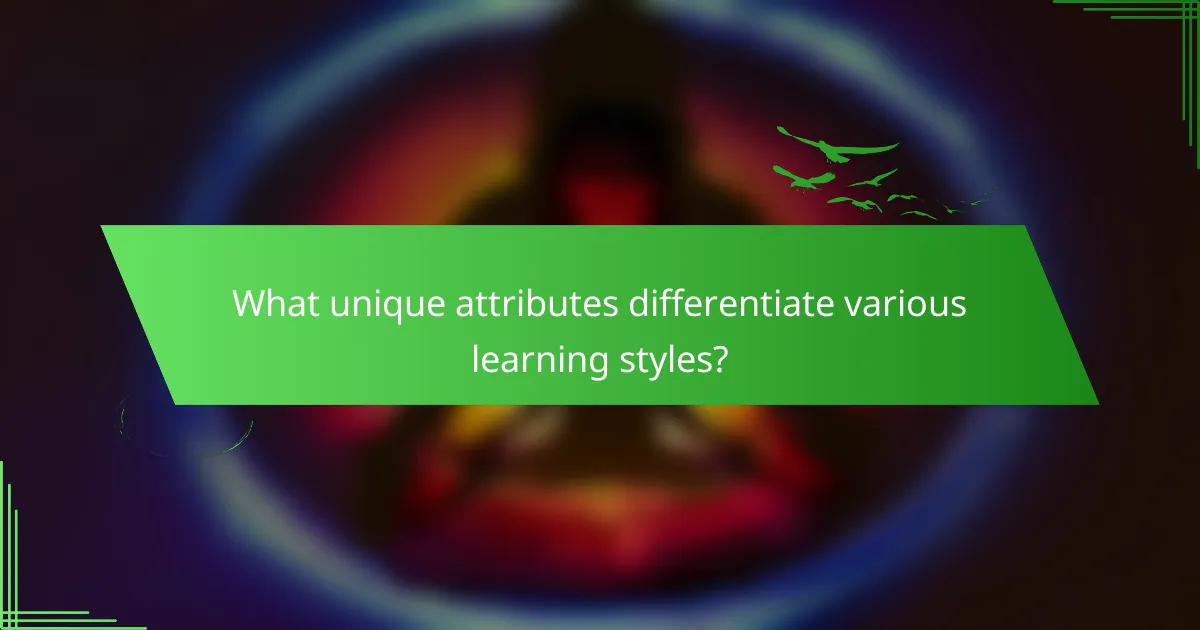
What unique attributes differentiate various learning styles?
Learning styles are differentiated by unique attributes such as sensory preferences, cognitive processes, and engagement techniques. For instance, visual learners benefit from diagrams, while auditory learners excel with lectures. Kinesthetic learners require hands-on activities to grasp concepts effectively. Each style influences teaching methods, making personalized approaches essential for optimal learning outcomes.
How do cultural factors shape learning preferences?
Cultural factors significantly influence learning preferences by shaping values, communication styles, and social interactions. For example, collectivist cultures often prioritize group learning, while individualistic cultures may favor independent study. Additionally, cultural attitudes toward authority can affect student engagement and participation. Understanding these cultural dimensions allows educators to tailor teaching techniques effectively, enhancing learning outcomes.
What role does technology play in supporting diverse learning styles?
Technology plays a crucial role in supporting diverse learning styles by providing tailored educational experiences. Various tools, such as adaptive learning platforms, cater to individual preferences, enhancing engagement and retention. For instance, multimedia resources accommodate visual learners, while interactive simulations benefit kinesthetic learners. Additionally, data analytics help educators identify unique attributes of learners, allowing for customized teaching strategies. As a result, technology fosters an inclusive learning environment that addresses the varying cognitive strategies of students.
What are the implications of multiple intelligences theory?
The implications of multiple intelligences theory significantly enhance teaching techniques by recognizing diverse learning styles. This understanding fosters individualized instruction, allowing educators to tailor approaches based on unique cognitive strategies. As a result, students engage more effectively, improving retention and comprehension. Furthermore, this theory promotes inclusive learning environments, accommodating various strengths and preferences, which ultimately leads to better educational outcomes.

What are the rare attributes associated with learning styles?
Rare attributes associated with learning styles include adaptability to unconventional teaching methods, preference for multi-sensory learning environments, and strong emotional connections to content. These attributes highlight unique ways individuals engage with material, enhancing retention and understanding.
How do atypical learning styles manifest in educational settings?
Atypical learning styles manifest in educational settings through diverse cognitive strategies and unique preferences. Students may exhibit strengths in visual, auditory, or kinesthetic modalities, influencing their engagement and retention. For example, a visual learner may benefit from diagrams, while an auditory learner excels with discussions. These differences necessitate tailored teaching techniques to enhance understanding and foster effective learning environments.
What challenges do educators face with rare learning styles?
Educators face significant challenges when addressing rare learning styles, including limited resources, insufficient training, and difficulty in assessment. These unique attributes require tailored instructional strategies that may not align with standard teaching methods. As a result, educators often struggle to create an inclusive environment that meets diverse needs. Additionally, the lack of awareness about these learning styles can hinder effective communication and collaboration among educators, parents, and students.
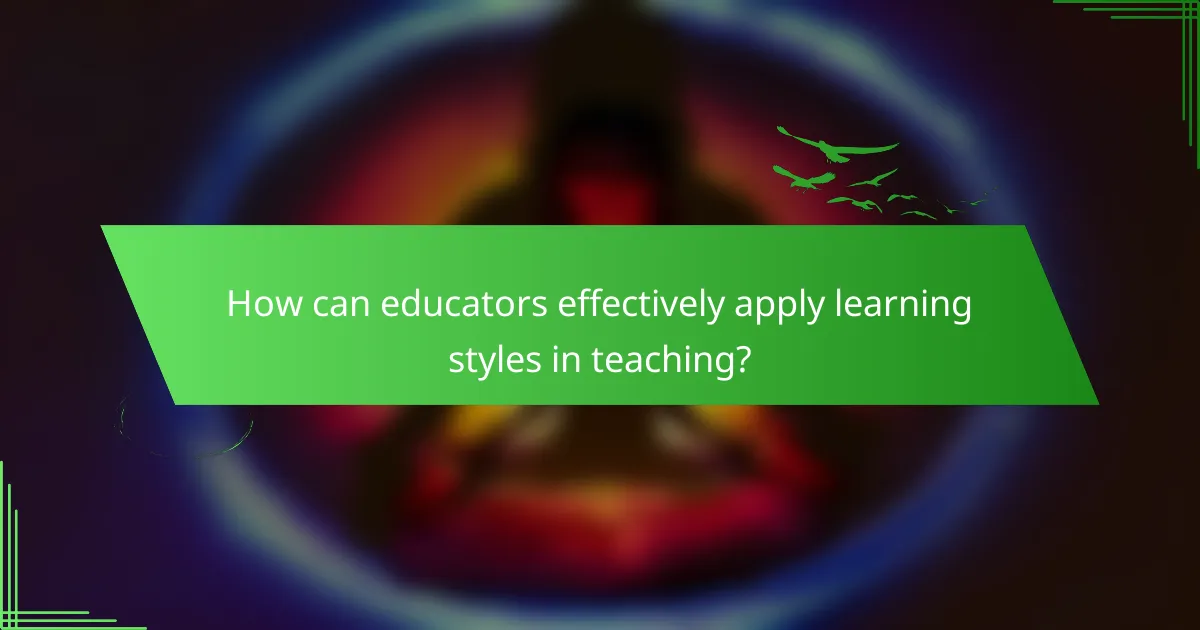
How can educators effectively apply learning styles in teaching?
Educators can effectively apply learning styles by tailoring their teaching methods to individual preferences. Recognizing diverse cognitive strategies enhances student engagement and retention.
Utilizing assessments to identify learning styles allows educators to customize lessons. For example, visual learners benefit from diagrams, while auditory learners thrive with discussions.
Incorporating varied instructional techniques fosters a more inclusive environment. Group activities, hands-on projects, and multimedia resources cater to different preferences, promoting deeper understanding.
Continuous feedback helps refine teaching approaches. Regularly assessing student progress ensures that instructional methods align with evolving needs, maximizing the impact of learning styles on education.
What strategies can be employed to cater to diverse learning preferences?
To cater to diverse learning preferences, employ strategies that include differentiated instruction, active learning techniques, and varied assessment methods. Differentiated instruction tailors content to individual needs, allowing for personalized learning experiences. Active learning techniques engage students through hands-on activities, fostering better retention. Varied assessment methods, such as projects or presentations, accommodate different strengths, ensuring all learners can demonstrate their understanding effectively.
What are the best practices for assessing learning styles?
To effectively assess learning styles, utilize diverse evaluation methods tailored to individual preferences. Begin with self-assessment questionnaires that identify preferred learning modalities. Incorporate observational assessments to gauge engagement in different learning activities. Conduct interviews to understand learners’ experiences and preferences. Use performance-based assessments to evaluate how well learners apply their preferred styles in practice. Finally, gather feedback to refine your understanding and adapt teaching techniques.
What common mistakes should educators avoid when implementing learning styles?
Educators should avoid several common mistakes when implementing learning styles. Focusing solely on one learning style can limit student engagement and understanding. Neglecting to assess students’ actual preferences leads to ineffective teaching strategies. Overemphasizing learning styles can result in a lack of flexibility in instructional methods. Lastly, failing to integrate diverse teaching techniques may hinder the development of critical thinking skills.

What expert insights can enhance understanding of learning styles?
Expert insights into learning styles emphasize the importance of tailoring educational approaches to individual preferences. Understanding cognitive strategies enhances student engagement and retention. Research indicates diverse learning styles, such as visual, auditory, and kinesthetic, influence how information is processed. Effective teaching techniques include differentiated instruction and active learning, allowing educators to address unique attributes of learners. Implementing these insights can significantly improve educational outcomes.
How can continuous professional development improve teaching techniques related to learning styles?
Continuous professional development enhances teaching techniques by equipping educators with strategies tailored to diverse learning styles. This approach fosters adaptability in instructional methods, leading to improved student engagement and comprehension. Educators gain insights into individual preferences, allowing for differentiated instruction that meets varied cognitive needs. As a result, students demonstrate higher retention rates and academic performance. Professional development programs often include workshops, peer collaboration, and evidence-based practices that emphasize the importance of recognizing and addressing learning styles in the classroom.
What future trends in educational psychology should be considered?
Future trends in educational psychology will emphasize personalized learning approaches, integrating technology, and understanding neurodiversity. These trends reflect a shift towards recognizing individual learning styles and cognitive strategies.
Personalized learning will utilize data analytics to tailor educational experiences to individual preferences. This customization can enhance engagement and retention.
Technological integration, through tools like AI and adaptive learning platforms, will facilitate real-time feedback and support diverse learning needs.
Understanding neurodiversity will promote inclusive teaching techniques, acknowledging varied cognitive processes among learners. This approach can lead to more effective educational outcomes.
